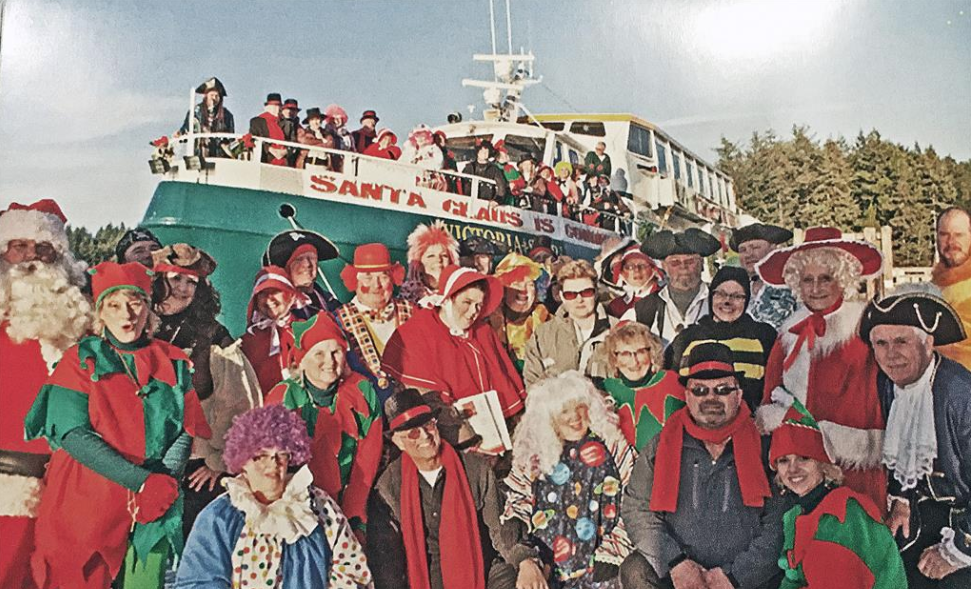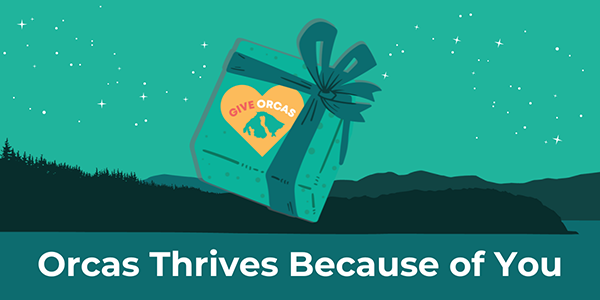||| FROM LYNN WEBER/ROOCHVARG |||
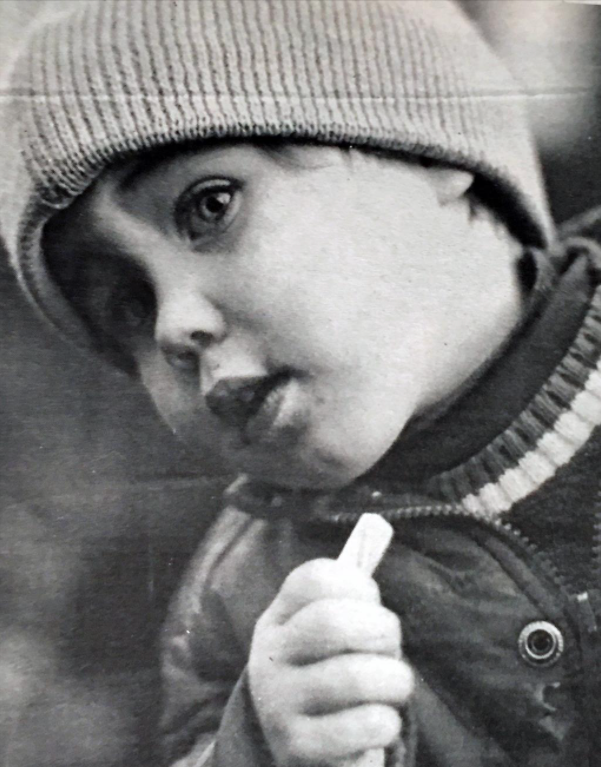
Child looking for Santa, Christmas Ship visit, Deer Harbor, Orcas Island, 1983 Journal of the San Juan Islands, December 14, 1983, p. B-7, Courtesy San Juan Historical Museum
On December 23, 1951, children in the San Juan Islands, who have little opportunity to meet Santa and give him their gift lists or even to see Christmas lights, are visited by a Christmas Ship from Bellingham, bearing a huge, festive, colorfully lighted tree and bringing Santa himself with gifts of candy.
That visit inaugurates an annual island tradition: Through subsequent years Christmas Ship sponsors and participants will change, but the anticipation and delight of islanders and the dedication of those bringing holiday joy to remote communities never diminishes. Each year, through often extremely stormy weather and rough seas, the ships and enthusiastic crews persevere and are warmly welcomed at every stop. One American ship on a one-day excursion will become some years two ships — Canadian (Santa Ship) and American (Christmas Ship) — each on two-day, cross-border trips as the number of visits expands to more islands in the San Juans and in Canada’s Gulf Islands. Later a single vessel will once again make the long journey, and throughout the islands the coming of the Christmas Ship will mark the real beginning of yuletide celebrations for many hundreds of appreciative families.
The First Ships
A few years after World War II, the long dark Pacific Northwest winter nights were brightened during the holiday season by a gaily lighted boat that traveled around Bellingham Bay in Whatcom County. (Some sources suggest that the ship may have made a visit to the San Juans as early as 1947.) During that time Don Wight (1919-2013), an aviator and skilled navigator who had served in the navy during World War II, had formed a Sea Scout unit of the Boy Scouts of America for young men in the Bellingham area. Needing funding for some of their activities, the scouts noted that the city had few Christmas-tree lots, a good potential project; contact was made with a source of trees on Orcas Island. The owner of the trees was willing for the scouts to have them, but he had a condition — that the scouts arrange for a lighted ship to make a visit to the island. He knew how enchanting such a sight would be to island children.
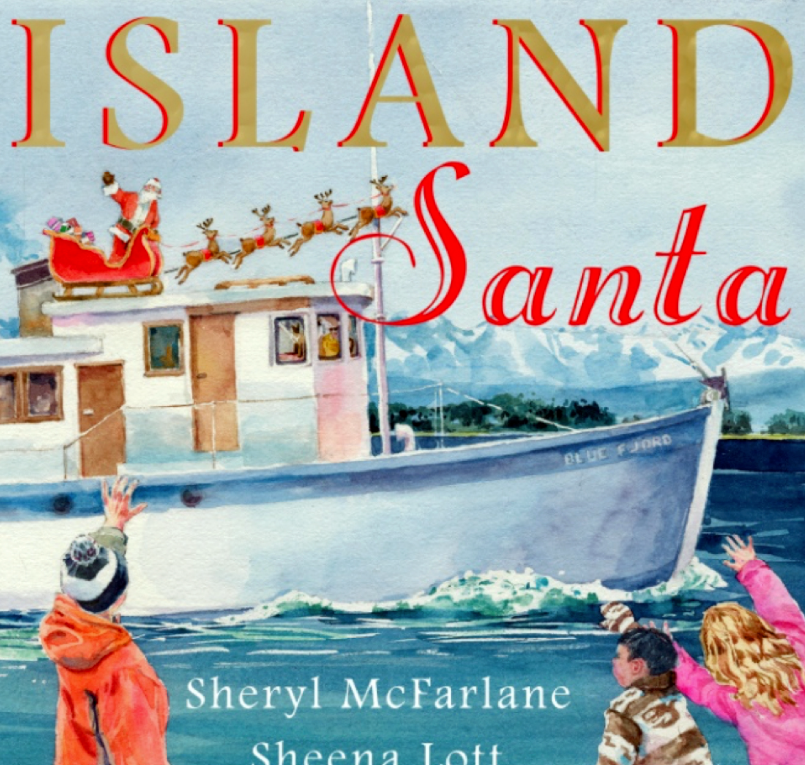
Cover, Island Santa by Sheryl McFarlane and Sheena Lott (Crow Cottage Publishing, 2013)
Early in the 1950s the San Juan Islands in the Salish Sea, west of mainland Washington and east of Canada’s Vancouver Island, were remote and homes often distant. The Washington State Ferries system was not established until 1951, and even then most of the population had few means of travel to the mainland, especially during unsettled winter weather. Island children rarely, if ever, had the opportunity to go to a department store or elsewhere to sit on Santa’s lap and whisper Christmas-gift wishes. Those living on smaller islands or in isolated communities often still had no electricity, so no lights decorated their Christmas trees. Then, in December 1951, a short notice appeared on the front page of the Friday Harbor Journal (FHJ), the only newspaper in San Juan County, announcing simply that a Christmas Ship would be arriving from Bellingham on December 23. No further information was provided.
Working out the logistics of that 1951 voyage was a challenge. The Sea Scouts, with support of the Bellingham Junior Chamber of Commerce (Jaycees) prepared hundreds of bags of candy and recruited a jolly Santa to give them out to the children. The Sea Scout vessel Eagle, sponsored by the Eagle Lodge and skippered by Don Wight, was outfitted with a 20-foot Christmas tree lashed to its mast and festooned with colored lights. Christmas carols and music would be played over a loudspeaker to announce the ship’s arrival. The plan was that at each stop Santa would disembark, meet with children and families at the dock, listen to Christmas wishes, and distribute his gifts of candy. That first year the ship left port in good weather and on calm waters, bound for Point Roberts (the small American community north of the islands on a peninsula surrounded by water and Canada), Waldron Island, Friday Harbor (on San Juan Island, the county seat and largest community), and a single stop for neighboring Shaw and Orcas Islands.
Those visits were a resounding success, and led to the Christmas Ship becoming an annual event, with the trip expanded to more communities. Lummi Island and Lopez Island were added to the schedule, as were two Gulf Islands, in the Canadian extension of the archipelago northwest of the San Juans. The weather was frequently not cooperative, but the ship faithfully sailed, although schedules were sometimes disrupted. In 1955 heavy winds and snow with freezing temperatures and high seas kept the ship from stopping at one of the Gulf Islands, and by the time the boat arrived at Waldron Island two hours late, the populace had given up and no one was waiting at the dock. But the crew knew that the children would be feeling disappointed, so a resident with a car was located, and Santa spent two hours going from home to home across the island distributing candy and bringing Christmas cheer to families on an otherwise dismal day. It was only one of many stormy crossings that often resulted in difficult, precarious landings and departures, and roiling seas that left Santa and his helpers seasonably but miserably green — and frightened — but no less determined to make sure that Santa (and soon Mrs.) Claus arrived as promised.
More Stops Added
The coming of the annual Christmas Ship quickly became a highlight of the holiday season in the islands. A woman from Olga on Orcas Island noted that her community emptied out almost entirely, as all the children demanded to go to the landing to greet Santa Claus. And a resident of Waldron Island wrote, “God rest ye merry gentlemen of ye old Christmas shippe … Old and young alike await at the dock and are touched by this symbol of Christmas, the gaily lighted tree, the music and singing, and the friendliness of jolly old Saint Nick and his helpers who bring gifts of candy and oranges to the wide-eyed youngsters” (“Waldron,” FHJ, December 20, 1956).
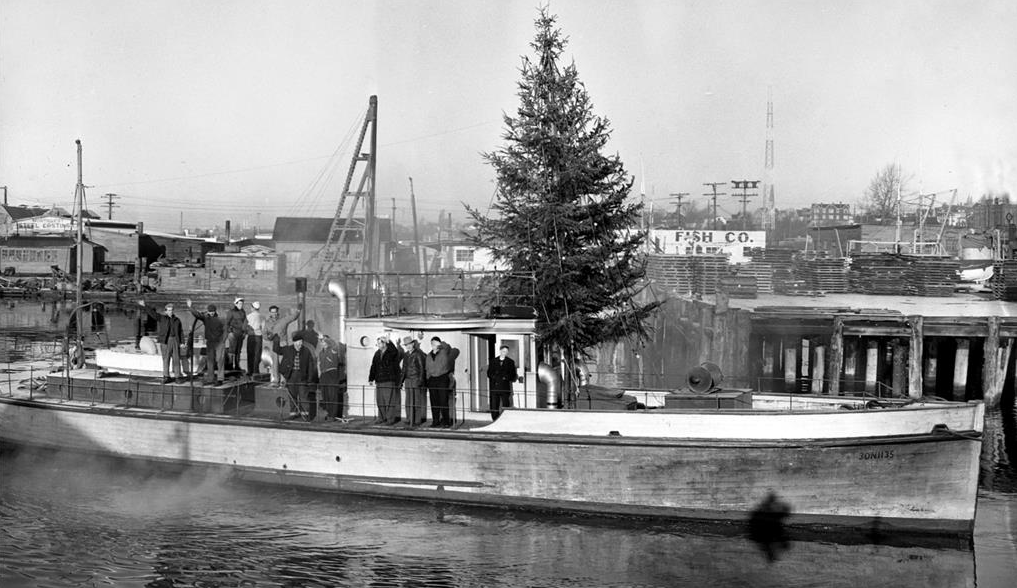
Bellingham Jaycees Christmas Ship, 1951 Photo by Jack Carver, Courtesy Whatcom Museum (1995.1.4441)
By the late 1950s eight more stops had been added, including three more Gulf Islands, Stuart and Blakeley islands, and little Patos Island where the lighthouse keeper’s family waited eagerly for Santa’s arrival. The Point Roberts stop was reluctantly eliminated as too far away. Friday Harbor lost out briefly as it was thought that the smaller islands needed more stops, but so many families were disappointed that it was soon put back on the schedule. More interest in this holiday venture was growing every year, and in 1960 the manager of KVOS Radio in Bellingham traveled with the Christmas Ship, broadcasting every half hour as it sailed from port to port.
The Bellingham Jaycees took on the trip as a major project, but the Sea Scouts continued their involvement. Don Wight’s son, also Don Wight (b. 1941), first served on the Christmas Ship as a 14-year-old Sea Scout and went on to sail on every subsequent trip, decades of those years as the ship’s captain. By 1961 the one-day sailing included 13 stops in the San Juan and Gulf islands. With financial assistance from the Bellingham Chamber of Commerce, the Jaycees filled enough bags of candy for 1,200 children expected to be waiting for Santa’s arrival.
New Challenges
For years the ship moved freely back and forth across the U.S.-Canada border from island to island on the most efficient route, and laws and regulations about international sailings were of little concern. Eventually, however, Canadian officials decided that the Christmas Ship should stop at Sidney on Vancouver Island for a full customs procedure before visiting any Gulf Islands. Such a stop would take the ship well off its usual route and absorb hours of precious time needed to get to each community, so an appeal was made to the Canadian government in Ottawa. With appropriate holiday spirit the government decided that when first entering Canadian waters, a Christmas Ship would be boarded by Royal Canadian Mounted Police who would do a brief inspection before allowing the ship to proceed. Through all the following years until the Covid-19 pandemic closed the border in 2020, both American and Canadian customs officials cooperated with and assisted the ships on their journeys, sometimes even providing honorary escorts.
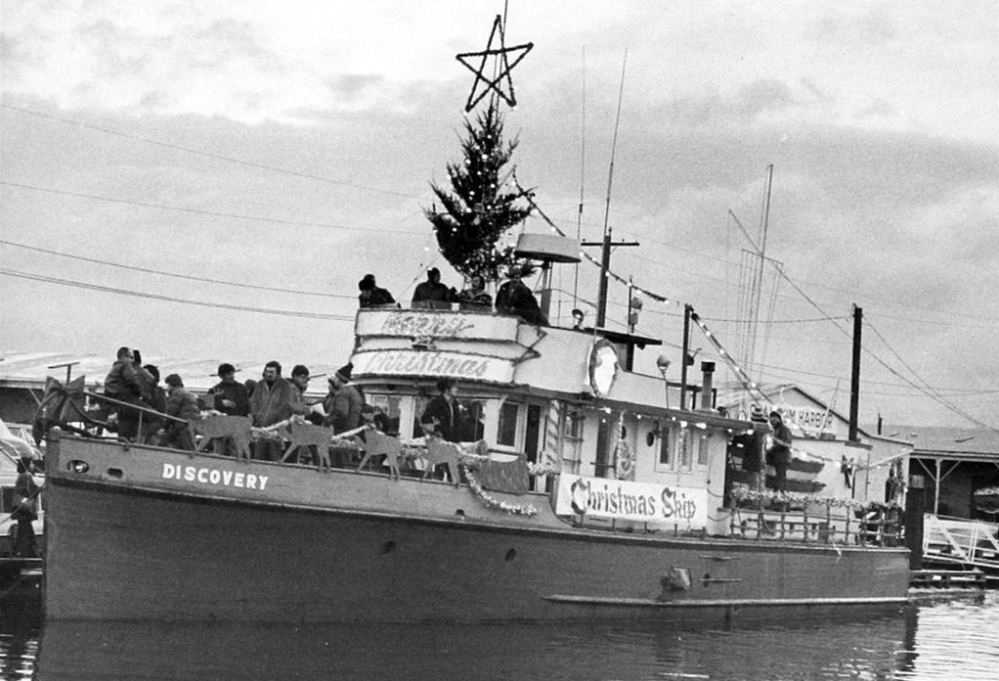
Bellingham Jaycees Christmas Ship, 1974 Courtesy Whatcom Museum (1996.10.5906b)
In 1962 the decision was made to extend the trip over two days as it was increasingly difficult to get to all the islands and for Santa to have enough time to spend with the children. The ship then had five Canadian stops including Pender Island, where it was always met by an American flag flying next to the Canadian flag at the dock. The flag had originally covered the casket of a Spanish American War veteran and was brought out annually “to extend greetings and neighborliness to friends from across the Gulf” (Smirley). That year the ship stayed overnight in Sidney, and the Jaycees of Victoria on Vancouver Island gave a party for the Bellingham Jaycees and crew where enthusiastic conversation gave birth to an idea. The following year the Victoria Jaycees, in cooperation and coordination with their Bellingham counterparts, launched their own Santa Ship to share the work and fun and expand the itinerary of visits. Both ships would undertake two-day journeys, and both would be crisscrossing the border on the best routes among the islands. If possible, the ships would meet and overnight together.
The Victoria Santa Ship was the 65-foot Blue Fjord, captained by Kaare Norgaard (1916-2005). The Victoria Jaycees decorated the ship with a tree, reindeer, and a golden sleigh for Santa, and made sure that Santa was supplied with candy, toys, books, and fruit. Along with its Gulf Islands visits, the ship from Victoria stopped at Roche Harbor (just across Haro Strait on San Juan Island), Waldron Island, Deer Harbor on Orcas Island, and Friday Harbor. On its first trip to Friday Harbor a letter of greeting from the mayor of Victoria was presented to the mayor of Friday Harbor together with a gift of tea and crumpets. In return, gifts were sent to the Victoria mayor with greetings, and two large boxes of oranges were given to the crew for the children in the Gulf Islands.
The Tradition Grows
With more time at each stop, and over subsequent years, celebrations became more elaborate. On some islands Santa met with families in a tent near the dock or in a school or community building. Large bonfires guided his way to several islands. The Bellingham crew added clowns to help Santa and entertain the families, and a band of pirates livened up the proceedings. Carolers in period costume brought Christmas music to each stop. On Waldron, Santa greeted the community before a roaring fire in the island’s log-cabin post office. When he arrived at Friday Harbor, Santa was transported on a decorated and lighted fire truck up the main street to the nursing home to greet the residents there and then to the middle or high school where children were invited to sit on Santa’s knee and cookies and hot cider were served. On some of the smallest islands, Santa, Mrs. Claus, and crew would receive gifts, a cake or holiday treat, or even a hot meal.
The Bellingham Christmas Ship’s last stop was Lummi Island where, as the ship approached with all lights on and Christmas music (often “Santa Claus is Coming to Town”) wafting across the water, a long line of cars filled with excited families waited on the road that ran along the water’s edge, and as the ship began to parallel the shore, the cars drove alongside, escorting it into the harbor. Enthusiastic bagpipers on the Victoria Santa Ship announced its arrival for several years. At some of the larger islands an entire parade of festively lighted boats would precede or follow Santa to the landing. And everywhere Santa “weathered the southerly gales” to joyfully greet “children … on both sides of the border who wait with mittens, mufflers, and red noses for the happy sound of the ship’s carols, as the international Santas come sailing into port once more with a ‘Merry Christmas to all!'” (“Santa’s Ship Sails …”).
The ships were becoming recognized both locally and nationally as a very special holiday event. In 1971 Charles Kuralt of the popular CBS television program On the Road chartered a boat to follow the Christmas Ship for an entire cruise for a feature segment, but the film was ruined while being processed and the program never aired. The Bellingham Jaycees and their Christmas Ship were featured on ABC’s national news. Newspapers in Bellingham, Friday Harbor, and British Columbia included photos and articles each year. The ships were featured in The Seattle Times “Rotogravure” section, Toronto Star Weekly, National Geographic School Bulletin, Sunset magazine, and numerous other publications, and on radio and television broadcasts.
The oil crisis of the early 1970s offered another challenge as the cost of the fuel needed for the ships’ long trips was extremely high, and money usually spent for toys had to be diverted to pay for ship operation. For the only time, the public was asked to help Santa by contributing toys that could be added to the sacks of dolls, stuffed animals, and other gifts given out at every stop. On the Christmas Ship’s 25th-anniversary sailing in 1975, the chairman of the event noted that it had “become an important Christmas happening to the thousands of youngsters and oldsters in the remote islands. For many children in the islands, the only Santa Claus they know is the one standing at the bow of the [Christmas Ship] as she enters port with a load of toys, candy, buccaneers, and old-fashioned goodwill” (“Bellingham Jaycees 25th Annual …”).
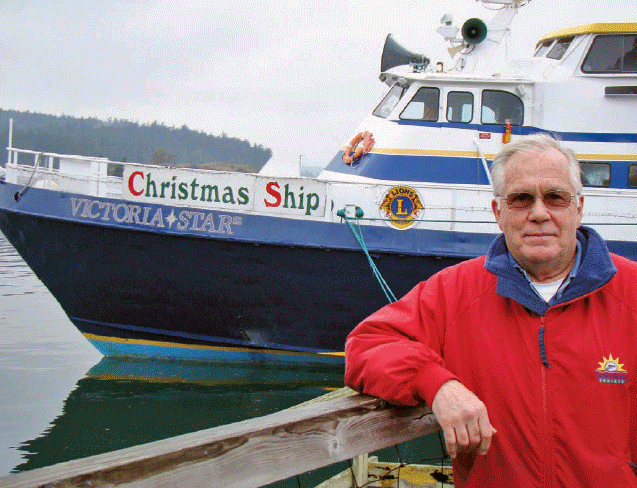
Don Wight (b. 1941) and Christmas Ship, ca. 2010 Photo by Chris Thomas, Courtesy theOrcasonian
In 1997 the Lions Club of Bellingham took over the Christmas Ship project, which became an important undertaking of the entire District 19-H of Lions Clubs International serving Southwest British Columbia and Northwest Washington. The Bellingham Central Lions Club was the largest of the district clubs, but there were now Lions groups on seven of the islands visited, and all (often including their associated LEOS young peoples’ groups) contributed assistance and financial backing to the event. On San Juan Island the local Lions Club, together in recent years with the Kiwanis Club, assumed full responsibility for bringing a more locally-based Santa by ship to Friday Harbor, leaving the Bellingham ship more time for its cross-border sailings.
The international Christmas Ship traveled hundreds of miles on the long journey through the islands in 2009, when an article in LION, the official magazine of Lions Clubs International, described the trips: “A few of the islands are only 15 minutes apart. The longest trip is two hours. But for islanders, the wait is a long year. The Christmas season doesn’t start until the Christmas ship docks” (Copp). As the new century began, some who had met the first ships as children were bringing their grandchildren to share in the excitement of the annual visit.
By the 2010s the Bellingham Christmas Ship carried a crew of 55 including two pairs of Santa and Mrs. Claus — two full days of energetic on-and-off-the-boat and often personal conversations with so many children and families were a bit too tiring for just one couple. Also on board were people to cook for the crew and prepare the bags of toys and candy, elves to help Santa and Mrs. Claus, as well as the carolers, pirates, and clowns. Dozens of others on shore had been fundraising throughout the year. Still others spent weeks preceding the voyage shopping, sorting, and preparing bags of toys and candy and transporting it all to the ships. Expenses had mounted, and the annual event now cost approximately $20,000, but the effort and expense were felt to be well worth it. By the end of the journey, “the volunteers are exhausted but after seeing the joy they have brought … they are also filled with joy themselves” (“Lions Christmas Ship 2014”).
Tradition Memorialized — and Interrupted
In Victoria, Kaare Norgaard, the Santa Ship skipper for many years, had been made an honorary citizen of the city, and his Norgaard Foundation had contributed generously to the building of Jeneece Place for the Children’s Health Foundation (CHF) of Vancouver Island. In recognition, CHF commissioned a children’s picture book from author Sheryl McFarlane and illustrator Sheena Lott with proceeds going to the foundation’s work with children. Island Santa is the story of a boy who sails with the Santa Ship, Norgaard’s Blue Fjord, as a passenger on the way to visit his sister who has been hospitalized. The watercolor illustrations tell the story of the voyage through stormy seas with glimpses of local fauna from seals to starfish and sea gulls, orcas to eagles, on the way to stops where families wait for Santa, and the boy helps bring Christmas cheer to delighted children. The book opens with the question parents all over the Salish Sea region hear every year: “‘When’s Santa coming to the island?'” (McFarlane, 2).
In 2015 the Bellingham Christmas Ship became a nonprofit corporation registered with the Washington Secretary of State, and through 2019 the Christmas Ship made its regular visits with the extensive help of local Lions Club members from many communities. Only the closing of the Canada/U.S. border in March 2020 and regulations concerning gatherings of large groups during the Covid-19 pandemic kept Santa from arriving as usual that year. Then in late 2021 the Lions district office announced:
“The Lions Christmas Cruise has been cancelled for the year 2021 because of unresolved issues [between Canada and the U.S.] regarding … requirements for vessels carrying passengers and guests on International Waters … There is no ship this side of the Great Lakes capable of qualifying in time for the 2021 Lions Christmas Ship cruise. On the singularly positive side, it appears that the Christmas Ship will be running in 2022” (“District 19-H Announcements”).
Adults and children of all ages in the San Juan and Gulf islands looked forward to the glad time when Santa would once again appear — not down a chimney or by airborne sleigh or on a motorized parade float but at the bow of his own holiday ship, an arrival that seems most appropriate to island life. And all those who volunteered untold hours to bring Santa to the islands hoped to soon be planning the next trip, thinking about all those excited faces and warm hugs that greet Santa, Mrs. Claus, and helpers at every stop. From fundraisers, organizers, and ship’s crew to Santa and Mrs. Claus, their helpers, elves, carolers, buccaneers, and clowns, the many dedicated individuals involved with this now-complex annual undertaking agreed there is no better way to experience the spirit of Christmas than by being a part of the Christmas Ship tradition.
Also published on HistoryLink.org
**If you are reading theOrcasonian for free, thank your fellow islanders. If you would like to support theOrcasonian CLICK HERE to set your modestly-priced, voluntary subscription. Otherwise, no worries; we’re happy to share with you.**

